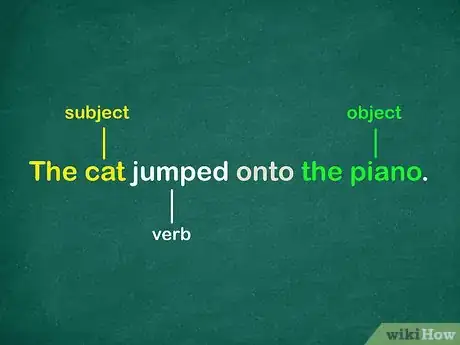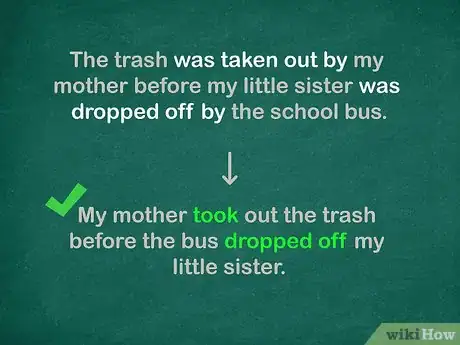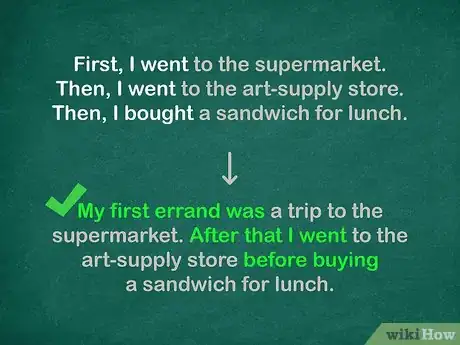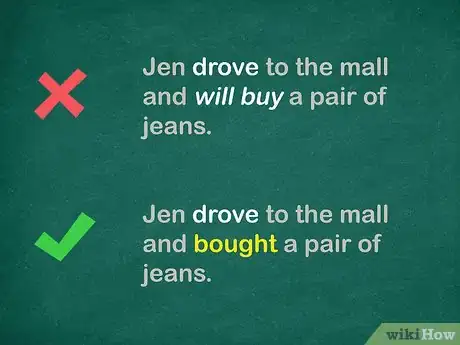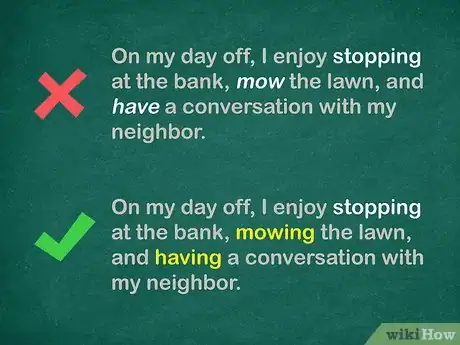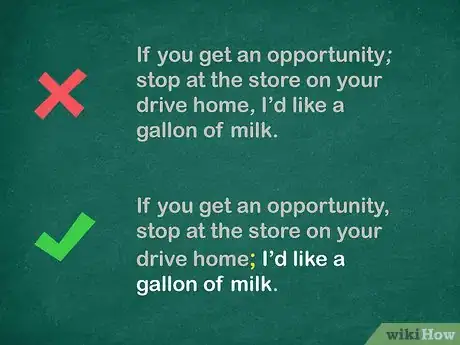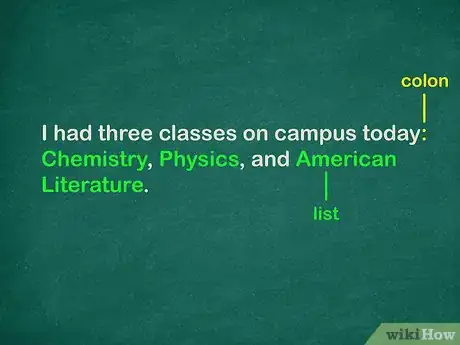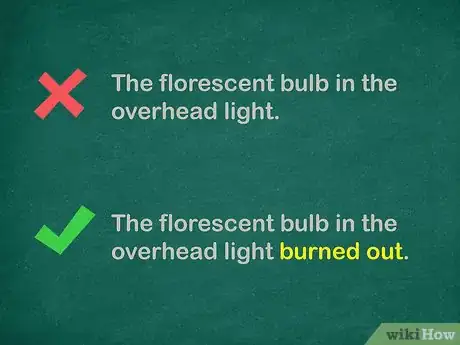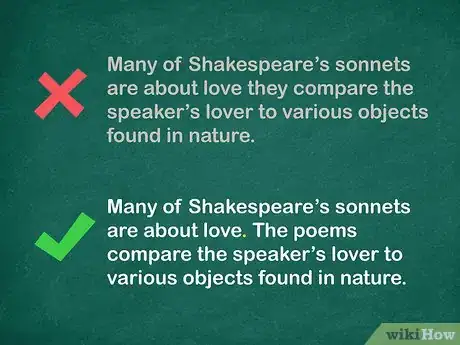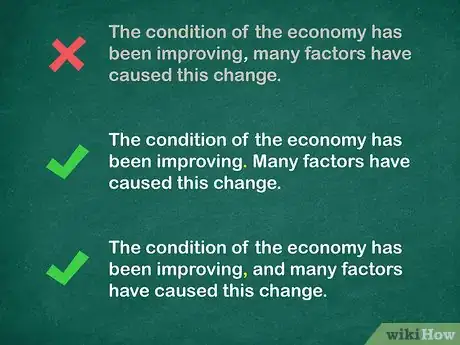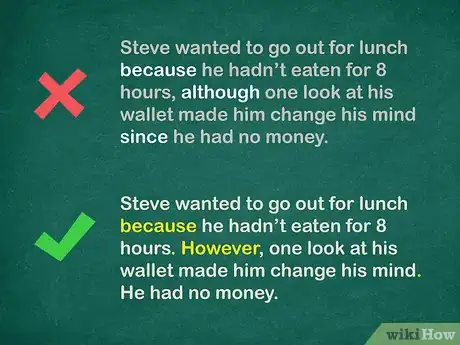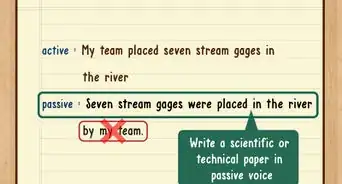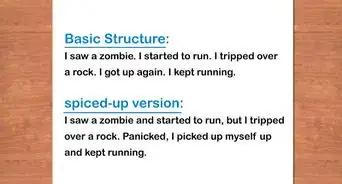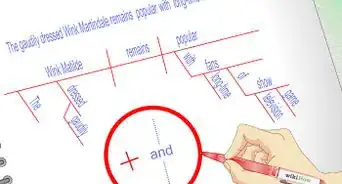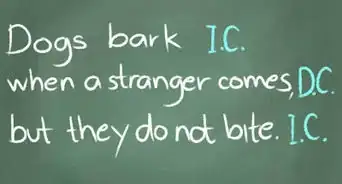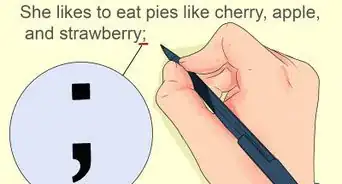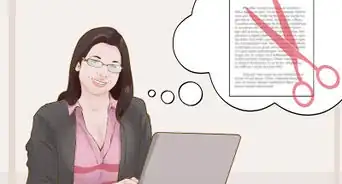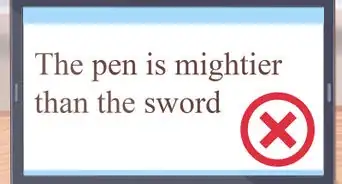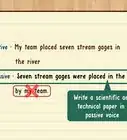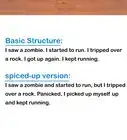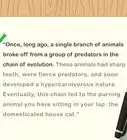This article was co-authored by Christopher Taylor, PhD. Christopher Taylor is an Adjunct Assistant Professor of English at Austin Community College in Texas. He received his PhD in English Literature and Medieval Studies from the University of Texas at Austin in 2014.
There are 10 references cited in this article, which can be found at the bottom of the page.
This article has been viewed 75,489 times.
If you’re learning English or trying to improve your writing skills, it’s important that you understand how to compose clear, effective, understandable sentences. To structure sentences well, begin by stating the subject, avoid the passive voice, and focus on clarity. Avoid writing sentences that only express partial thoughts or that join too many ideas together.
Steps
Composing Effective Sentences
-
1Begin your sentence with the subject, followed by the verb and object. This structure is commonly used to build sentences in the English language and is abbreviated “SVO.” Sentences written with a different word order often seem confusing or backwards. So, instead of writing “A jump was made by the cat onto the piano," write “The cat jumped onto the piano.”[1]
- The subject is the person or thing doing an action (in our example, the cat).
- The object is the person or thing to which the action is done (in our example, the piano).
- The SVO structure is used to create simple sentences. When you create compound and complex sentences, you'll add to this basic structure.
-
2Write in the active voice to clarify the action taking place. When you write in the active voice, you make it clear who or what is performing a specific action. Using the passive voice results in weak and potentially ambiguous sentences in most situations. Sentences in the passive voice also often have a jumbled, confusing structure. So, state the subject of your sentence first, and clarify the action that the subject is performing.[2]
- Avoid writing something like: “The trash was taken out by my mother before my little sister was dropped off by the school bus.”
- Instead, try writing: “My mother took out the trash before the bus dropped off my little sister.”
Advertisement -
3Vary your sentence length and structures to avoid boring your readers. If every sentence in a paragraph begins with a similar phrase, is roughly the same length, or has a similar pattern of words, the sentences will start to seem dull and repetitive. To avoid this, change the sentence structures. Try making some sentences longer, joining sentences with conjunctions and semicolons, and making other sentences shorter and more direct.[3]
- You can combine two short sentences, which are independent clauses, into a single longer sentence by adding a comma and a conjunction between them. You can remember your conjunctions by using the acronym FANBOYS, which helps you remember "for," "and," "but," "or," "yet," and "so."
- If you have one complete sentence and one incomplete or subordinate sentence, you can combine them into a complex sentence with a comma or by adding a conjunction like "because," "since," while," or "although." The complete sentence is an independent clause, while the incomplete sentence becomes a dependent or subordinating clause.
- Add transitional words and phrases to the beginnings of your sentences to create a flow between your ideas. Otherwise, your sentences might seem choppy.
- So, avoid writing sentences like: “First, I went to the supermarket. Then, I went to the art-supply store. Then, I bought a sandwich for lunch.”
- Instead, change the structure to something like: “My first errand was a trip to the supermarket. After that I went to the art-supply store before buying a sandwich for lunch.”
-
4Maintain a consistent verb tense in your sentences. As sentences lengthen, it can be easy to lose track of the tense (e.g., past, present, or future) in which you’re writing the sentence. In nearly all cases, it’s both confusing and grammatically incorrect to switch verb tense in the middle of a sentence.[4]
- This sentence switches tenses: “Jen drove to the mall and will buy a pair of jeans.”
- Corrected, it reads: “Jen drove to the mall and bought a pair of jeans.”
-
5Write with parallel structure when composing a list or sequence. If you create a sentence that describes 2 or more objects or actions, the different elements must be described using the same grammatical terms. If the descriptions are not parallel, the sentence becomes confusing. Keeping verb tense the same is an important part of maintaining parallel structure.[5]
- For example, this sentence doesn’t contain parallel structure: “On my day off, I enjoy stopping at the bank, mow the lawn, and have a conversation with my neighbor.”
- Corrected, it reads: “On my day off, I enjoy stopping at the bank, mowing the lawn, and having a conversation with my neighbor.”
-
6Use a semicolon to join 2 independent clauses. If you’d rather not use a period or a conjunction to join 2 independent clauses, place a semicolon between the clauses instead. Adding a semicolon is a great way to convert 2 simple sentences into 1 compound sentence, and lets you connect sentences whose main ideas are closely related.[6]
- For example, this sentence contains a semicolon in the wrong location since it is not between the independent clauses: “If you get an opportunity; stop at the store on your drive home, I’d like a gallon of milk.”
- Corrected, it would read: “If you get an opportunity, stop at the store on your drive home; I’d like a gallon of milk.”
-
7Add a colon to sentences to introduce a list or a noun phrase. Also use a colon to indicate a quotation in your sentence. A colon sets apart the words that follow it and draws attention to them. If you omit the colon from a sentence, it will have an awkward feel and confuse readers.[7]
- For example, it’s correct to write, “I had three classes on campus today: Chemistry, Physics, and American Literature.”
- You can also write, “As they made their getaway, the bank robbers forgot something important: the loot from the safe.”
-
8Use commas to join two clauses or set off a descriptive clause. To combine two independent clauses, which are complete sentences, put a comma and one of your FANBOYS between them. As another option, use a comma to set off a dependent or subordinating conjunction. Similarly, you'll put commas on either side of a descriptive clause to set it apart from the rest of the sentence.[8]
- For instance, you might join two independent clauses like this: "I finished my homework early today, so my best friend came over to hang out."
- You could join a dependent and independent clause like this: "Since my grades are good this semester, my parents said I can have a party this weekend."
- If you had a descriptive clause, here's how you'd include it in your sentence: "I want to try that new pizza place, the one with pepperoni on its sign, when we go out on Friday."
Fixing Problems in Sentence Structures
-
1Fix sentence fragments by adding a subject or object. Sentence fragments are incomplete sentences that lack either a subject, a verb, or an object. To remedy the problem, add the missing part of speech.[9] For example, “The fluorescent bulb in the overhead light” is a fragment because it has no verb. Once corrected, it reads: “The fluorescent bulb in the overhead light burned out.”
- Dependent clauses that are not joined to an independent clause are also sentence fragments.
-
2Correct fused sentences by adding a conjunction. Alternately, use a period to break the fused sentence into 2 separate sentences. Fused sentences occur when 2 (or more) full sentences are put together without any punctuation between them.[10] The most effective way to correct a fused sentence is to place a period (or other end punctuation) between the 2 fused sentences. Correct the grammar as needed so the sentences make sense.
- Fused sentences are commonly called "run-on" sentences.
- For example, “Many of Shakespeare’s sonnets are about love they compare the speaker’s lover to various objects found in nature” is a fused sentence.
- Corrected, it reads: “Many of Shakespeare’s sonnets are about love. The poems compare the speaker’s lover to various objects found in nature.”
-
3Add a conjunction between clauses to fix comma splices. A comma splice occurs when 2 independent clauses are joined together with only a comma. Fix this by replacing the comma with a period (or other end punctuation) to separate the sentences formerly joined by a comma splice. Alternately, fix a comma splice by placing a conjunction between the 2 clauses.[11]
- For example, this sentence contains a comma splice: “The condition of the economy has been improving, many factors have caused this change.”
- Corrected, it reads: “The condition of the economy has been improving. Many factors have caused this change.”
- This is also correct: “The condition of the economy has been improving, and many factors have caused this change.”
-
4Avoid using excessive subordinate clauses. Subordinate clauses begin with words like “because” and “although” and provide helpful (but not necessary) information to the reader. Sentences with too much subordination often feel bloated and contain more information than the reader can process. To fix this, break the sentence up into 2-3 smaller, clearer sentences.[12]
- This sentence contains too much subordination: “Steve wanted to go out for lunch because he hadn’t eaten for 8 hours, although one look at his wallet made him change his mind since he had no money.”
- Corrected, it could read: “Steve wanted to go out for lunch because he hadn’t eaten for 8 hours. However, one look at his wallet made him change his mind. He had no money.”
Expert Q&A
Did you know you can get expert answers for this article?
Unlock expert answers by supporting wikiHow
-
QuestionHow do I understand the difference of, in, on and at?
 Christopher Taylor, PhDChristopher Taylor is an Adjunct Assistant Professor of English at Austin Community College in Texas. He received his PhD in English Literature and Medieval Studies from the University of Texas at Austin in 2014.
Christopher Taylor, PhDChristopher Taylor is an Adjunct Assistant Professor of English at Austin Community College in Texas. He received his PhD in English Literature and Medieval Studies from the University of Texas at Austin in 2014.
English Professor Each of these words are prepositions, which means they tell you the location of something. It's hard for many people to choose the best preposition to use, but you can get better by practicing. First, think about which word might logically make sense for the item you're talking about. If you still aren't sure, do a quick Internet search of the preposition you plan to use to make sure it's right.
Each of these words are prepositions, which means they tell you the location of something. It's hard for many people to choose the best preposition to use, but you can get better by practicing. First, think about which word might logically make sense for the item you're talking about. If you still aren't sure, do a quick Internet search of the preposition you plan to use to make sure it's right.
References
- ↑ https://www.plainlanguage.gov/guidelines/concise/keep-the-subject-verb-and-object-close-together/
- ↑ https://writing.wisc.edu/handbook/style/ccs_activevoice/
- ↑ https://academicguides.waldenu.edu/writingcenter/scholarlyvoice/sentencestructure
- ↑ https://academicguides.waldenu.edu/writingcenter/grammar/verbtenses
- ↑ https://owl.purdue.edu/owl/general_writing/mechanics/parallel_structure.html
- ↑ https://writingcenter.unc.edu/tips-and-tools/semi-colons-colons-and-dashes/
- ↑ https://writingcenter.unc.edu/tips-and-tools/semi-colons-colons-and-dashes/
- ↑ https://owl.purdue.edu/owl/general_writing/punctuation/commas/extended_rules_for_commas.html
- ↑ https://guides.lib.uoguelph.ca/Grammar/SentenceStructure
- ↑ https://guides.lib.uoguelph.ca/Grammar/SentenceStructure
- ↑ https://guides.lib.uoguelph.ca/Grammar/SentenceStructure
- ↑ https://owl.purdue.edu/owl/general_writing/mechanics/sentence_clarity.html
- ↑ https://www2.le.ac.uk/offices/ld/resources/writing/grammar/grammar-guides/sentence
- ↑ https://www2.le.ac.uk/offices/ld/resources/writing/grammar/grammar-guides/sentence
- ↑ https://www2.le.ac.uk/offices/ld/resources/writing/grammar/grammar-guides/sentence
